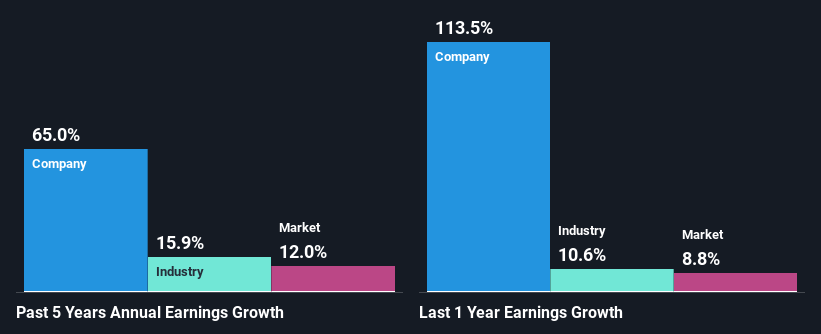- Saudi Arabia
- /
- Electrical
- /
- SASE:1303
Is Electrical Industries Company's (TADAWUL:1303) Latest Stock Performance A Reflection Of Its Financial Health?

Most readers would already be aware that Electrical Industries' (TADAWUL:1303) stock increased significantly by 54% over the past three months. Since the market usually pay for a company’s long-term fundamentals, we decided to study the company’s key performance indicators to see if they could be influencing the market. In this article, we decided to focus on Electrical Industries' ROE.
Return on equity or ROE is an important factor to be considered by a shareholder because it tells them how effectively their capital is being reinvested. Put another way, it reveals the company's success at turning shareholder investments into profits.
See our latest analysis for Electrical Industries
How Is ROE Calculated?
The formula for return on equity is:
Return on Equity = Net Profit (from continuing operations) ÷ Shareholders' Equity
So, based on the above formula, the ROE for Electrical Industries is:
27% = ر.س201m ÷ ر.س745m (Based on the trailing twelve months to December 2023).
The 'return' is the profit over the last twelve months. Another way to think of that is that for every SAR1 worth of equity, the company was able to earn SAR0.27 in profit.
What Has ROE Got To Do With Earnings Growth?
Thus far, we have learned that ROE measures how efficiently a company is generating its profits. We now need to evaluate how much profit the company reinvests or "retains" for future growth which then gives us an idea about the growth potential of the company. Assuming everything else remains unchanged, the higher the ROE and profit retention, the higher the growth rate of a company compared to companies that don't necessarily bear these characteristics.
Electrical Industries' Earnings Growth And 27% ROE
To begin with, Electrical Industries seems to have a respectable ROE. Especially when compared to the industry average of 8.0% the company's ROE looks pretty impressive. This probably laid the ground for Electrical Industries' significant 65% net income growth seen over the past five years. We believe that there might also be other aspects that are positively influencing the company's earnings growth. Such as - high earnings retention or an efficient management in place.
As a next step, we compared Electrical Industries' net income growth with the industry, and pleasingly, we found that the growth seen by the company is higher than the average industry growth of 16%.

Earnings growth is an important metric to consider when valuing a stock. The investor should try to establish if the expected growth or decline in earnings, whichever the case may be, is priced in. By doing so, they will have an idea if the stock is headed into clear blue waters or if swampy waters await. One good indicator of expected earnings growth is the P/E ratio which determines the price the market is willing to pay for a stock based on its earnings prospects. So, you may want to check if Electrical Industries is trading on a high P/E or a low P/E, relative to its industry.
Is Electrical Industries Efficiently Re-investing Its Profits?
The high three-year median payout ratio of 69% (implying that it keeps only 31% of profits) for Electrical Industries suggests that the company's growth wasn't really hampered despite it returning most of the earnings to its shareholders.
Additionally, Electrical Industries has paid dividends over a period of nine years which means that the company is pretty serious about sharing its profits with shareholders.
Summary
Overall, we are quite pleased with Electrical Industries' performance. In particular, its high ROE is quite noteworthy and also the probable explanation behind its considerable earnings growth. Yet, the company is retaining a small portion of its profits. Which means that the company has been able to grow its earnings in spite of it, so that's not too bad. Until now, we have only just grazed the surface of the company's past performance by looking at the company's fundamentals. So it may be worth checking this free detailed graph of Electrical Industries' past earnings, as well as revenue and cash flows to get a deeper insight into the company's performance.
Valuation is complex, but we're here to simplify it.
Discover if Electrical Industries might be undervalued or overvalued with our detailed analysis, featuring fair value estimates, potential risks, dividends, insider trades, and its financial condition.
Access Free AnalysisHave feedback on this article? Concerned about the content? Get in touch with us directly. Alternatively, email editorial-team (at) simplywallst.com.
This article by Simply Wall St is general in nature. We provide commentary based on historical data and analyst forecasts only using an unbiased methodology and our articles are not intended to be financial advice. It does not constitute a recommendation to buy or sell any stock, and does not take account of your objectives, or your financial situation. We aim to bring you long-term focused analysis driven by fundamental data. Note that our analysis may not factor in the latest price-sensitive company announcements or qualitative material. Simply Wall St has no position in any stocks mentioned.
About SASE:1303
Electrical Industries
Through its subsidiaries, engages in the manufacture, assembly, supply, and maintenance of various electrical equipment; and provision of technical services in the Kingdom of Saudi Arabia, other Gulf countries, Europe, and Asia.
Outstanding track record with flawless balance sheet and pays a dividend.

